DFID Gender Pay Gap Report 2018
Published 19 December 2018
Introduction
The Department for International Development (DFID) leads the UK’s work to end extreme poverty, building a safer, healthier, more prosperous world for all of us which is firmly in the UK’s national interest. We’re ending the need for aid by creating jobs, unlocking the potential of girls and women, and helping to save lives when humanitarian emergencies hit.
DFID has over 3000 staff with head offices in London and East Kilbride (near Glasgow) and substantial teams in more than 30 countries across Africa, Asia and the Middle East. Our pay approach is designed to support fair treatment and reward all our staff regardless of gender. We are committed to being an inclusive employer by offering opportunities that will help staff realise their full potential and recognise their contribution to DFID’s, and the wider UK Government’s ambitions. Building a diverse and inclusive workforce that reflect the people we serve is one of the Civil Service’s top workforce priorities. Our collective aim is to make the Civil Service the UK’s most inclusive employer by 2020. Our Diversity & Inclusion Strategy outlines how we plan to achieve this. The Civil Service should create opportunities for all in a truly meritocratic way and reward all civil servants fairly, regardless of gender, ethnicity or any other personal characteristic.
In 2017, the Government introduced world-leading legislation that made it statutory for organisations with 250 or more employees to report annually on their gender pay gap. Government departments are covered by the Equality Act 2010 (Specific Duties and Public Authorities) Regulations 2017 which came into force on 31 March 2017. These regulations underpin the Public Sector Equality Duty and require the relevant organisations to publish their gender pay gap data by 30 March annually. This includes the mean and median gender pay gaps; the mean and median gender bonus gaps; the proportion of men and women who received bonuses; and the proportions of male and female employees in each pay quartile.
The gender pay gap shows the difference in the average pay between all men and women in a workforce. If a workforce has a particularly high gender pay gap, this can indicate there may be a number of issues to deal with, and the individual calculations may help to identify what those issues are.
The gender pay gap is different to equal pay. Equal pay deals with the pay differences between men and women who carry out the same jobs, similar jobs or work of equal value. It is unlawful to pay people unequally because they are a man or a woman.
Under Gender Pay Gap reporting, we are required to report on the difference between men and women who work in DFID in relation to:
- mean hourly rate of pay
- median hourly rate of pay
- mean bonus paid
- median bonus paid
The proportions of:
- men and women who were paid a bonus
- men and women in the 1st (lower) quartile, 2nd, 3rd, and 4th (upper) quartile pay bands
Definitions
The Regulations require information to be reported under the following definitions.
The mean average is calculated by adding together all the values and dividing by the number of values. In this case a mean average is calculated for men, a mean average is calculated for women, and the 2 mean averages are compared.
The median average is calculated by sorting the values into an order from lowest to highest, and then finding the value that is in the middle of that sorted list. In this case a median average is calculated for men, a median average is calculated for women, and the 2 median averages are compared.
The pay quartiles are hourly pay for all staff. They are sorted into order from lowest amount to highest amount. This ordered list is then split into 4 equal parts, known as quartiles. The lowest pay quartile contains the first quarter of the ordered list, that is the 25% of the list with the lowest hourly rates of pay. The upper quartile contains the 25% of staff whose hourly rates of pay are the highest. Quartiles are related to the median average, as the median average marks the point between the second and third quartile.
Statement
DFID confirms that our data has been calculated according to the requirements of the Equality Act 2010 (Specific Duties and Public Authorities) Regulations 2017.
Locally engaged staff who are contracted outside of the UK are not covered by the definition of employee for the purpose of gender pay gap reporting and are not included in the calculations.
Pay data used for this report is based on employee pay on the snapshot date of 31 March 2018 (including bonuses paid at 31 March 2018) and bonus pay for the period 1 April 2017 to 31 March 2018.
Gender pay gap and bonus pay
Explaining our gender pay gap
As in previous years, DFID continues to have a high proportion of its roles in more senior managerial grades (A1 – A2L). While men continue to be over-represented in these roles, this gap has narrowed proportionally, helping to narrow the gender pay gap within the organisation. Women are over-represented in lower grades, particularly outside London, where positions are paid at the lower, national rate. This continues to be a key driver of DFID’s overall mean and median gender pay gaps.
As well as DFID’s overall mean gender pay gap for the organisation narrowing from 8.5% in 2016 to 2017 to 6.9% in 2017 to 2018, most gaps within individual grades have also reduced by up to 3.1 percentage points, with only 2 grades seeing an increase in the mean gap. The pay gap for the Senior Civil Servants (SCS) is close to the overall mean reflecting the fact that this group covers 4 pay bands (SCS 1 to 4). There is almost an equal split of men and women in DFID’s senior grades, with 48 and 43 respectively.
Profile of the workforce
This report contains information for 2,534 employees as at 31 March 2018 as required by the Gender Pay gap regulations. It does not include data for locally employed staff overseas, contractors or consultants.
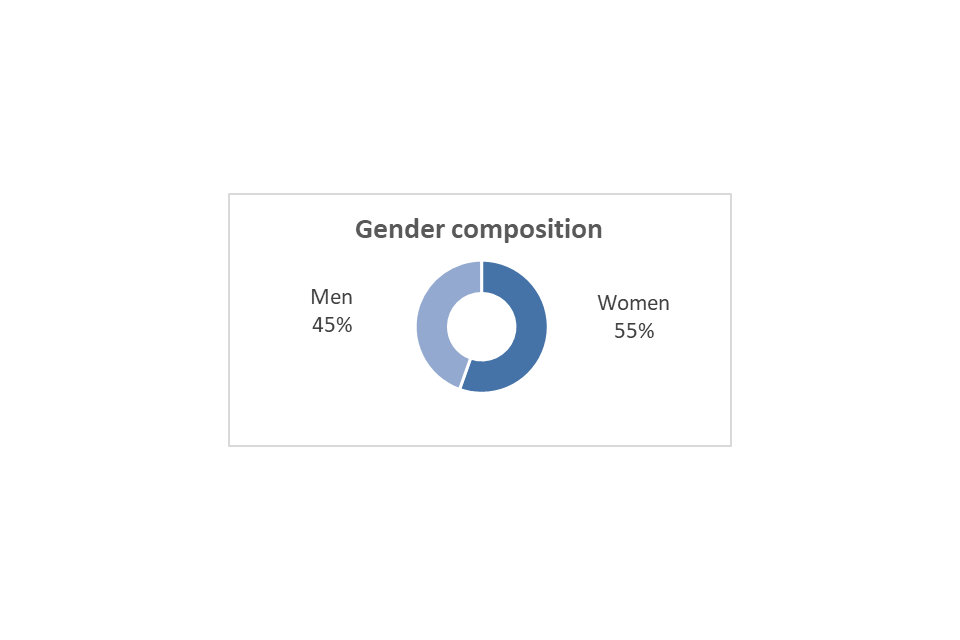
Gender composition chart
In 2017 to 2018 women made up 55% of DFID’s workforce. Women make up 53.9% of the wider Civil Service so DFID is broadly similar[footnote 1]. There has been very little movement in the gender composition in the last year.
Grade breakdown[footnote 2].
| Grade | Number of Men | % of total men | Men at grade | Number of Women | % of total women | Women at grade | Mean Pay Gap | Median Pay Gap |
|---|---|---|---|---|---|---|---|---|
| SCS | 48 | 4% | 53% | 43 | 3% | 47% | 5.5% | -0.4% |
| A1 | 242 | 22% | 51% | 228 | 17% | 49% | 1.5% | 0.0% |
| A2 | 389 | 35% | 45% | 467 | 35% | 55% | 0.4% | -0.3% |
| A2L | 120 | 11% | 43% | 161 | 12% | 57% | 3.0% | 3.8% |
| B1 | 169 | 15% | 41% | 244 | 18% | 59% | 1.1% | 6.6% |
| B2 | 93 | 8% | 37% | 156 | 12% | 63% | 3.6% | 8.8% |
| C1 | 41 | 4% | 43% | 54 | 4% | 57% | 0.0% | 0.5% |
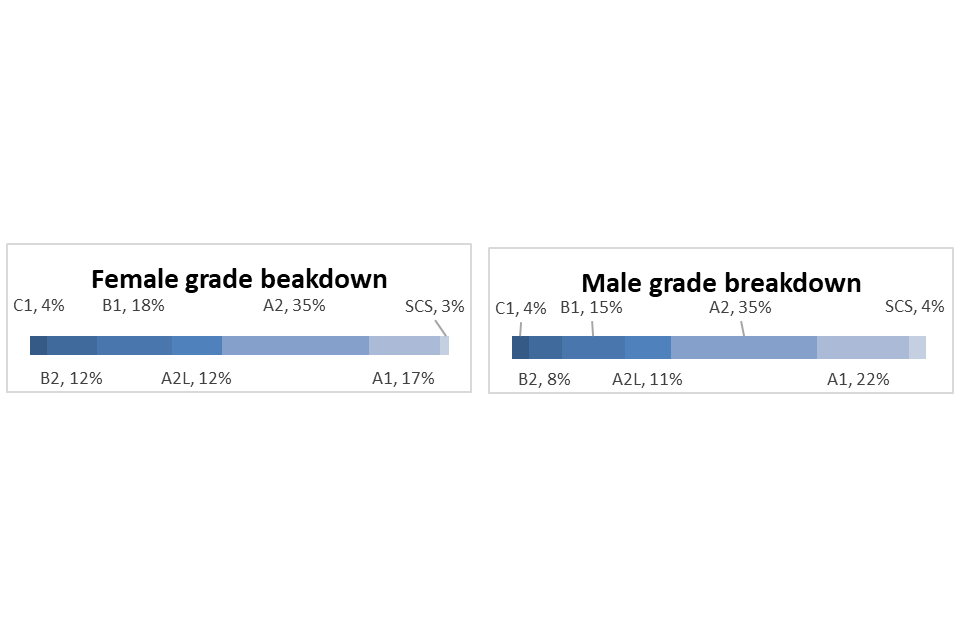
Grade breakdown
Grade comparison 2016 to 2017 and 2017 to 2018
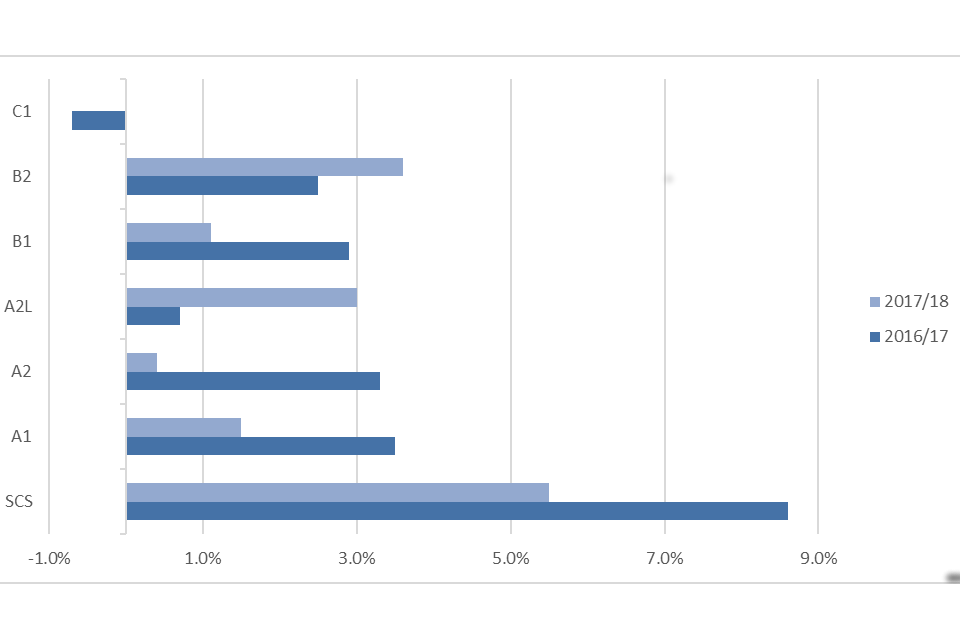
Grade comparison 2016-17 to 2017-18
It can be seen that most grades have a trend going towards a 0% gender pay gap with the exception of A2L and B2 grades which are the only grades whose gap has widened this year.
Basic Pay
Basic pay in terms of the Gender Pay Gap Legislation for DFID is the basic salary, any specialist allowances (such as IT) and any pay for leave that was paid in the relevant period of the snapshot data. The difference in hourly pay at 31 March 2018 between men and women is shown below.
Mean = 6.9%, Median = 9.1%
The mean hourly pay for men in DFID is 6.9% higher than the mean hourly pay for women. The median hourly pay for men is also higher, with men’s median hourly pay being 9.1% higher than the median hourly pay for women.
The mean pay gap has decreased by 1.7[footnote 3]. percentage points between 2016 to 2017 and 2017 to 2018. This is due to a slight closing of the gap between the share of male and female employees at each grade within DFID. However, the median pay gap has increased by 2.2[footnote 4]. percentage points from 2016/17, to 9.1%. The salary for the median female has decreased from 2016 to 2017 while the salary for the median male has remained the same. This is due to slightly more women than men being successfully recruited at lower grades.
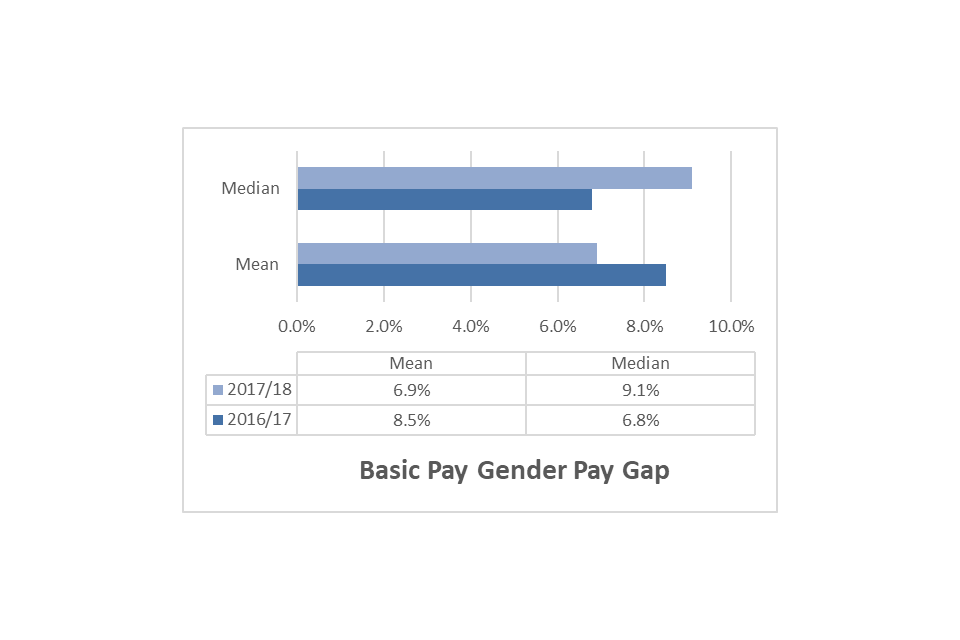
Basic Pay Gender Pay Gap
Pay Quartiles
Almost 63% of workers in the lowest pay quartile were women, compared with over 48% of employees in the top pay quartile. As shown in the grade breakdown table there are fewer women in the highest grades (SCS and A1) which is reflected in the gender spilt across pay quartiles.
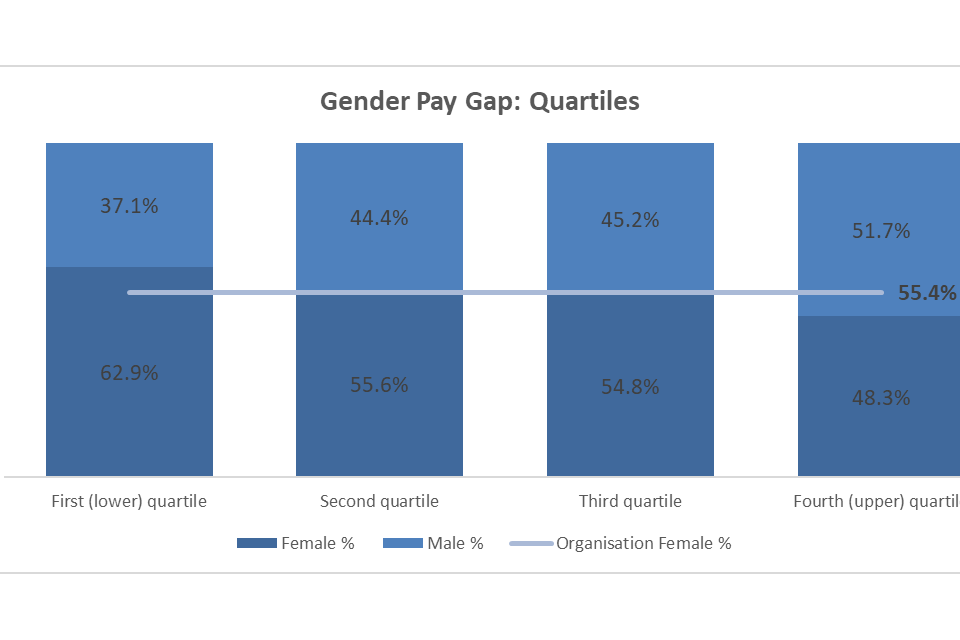
Gender Pay Gap: Quartiles
The ratio of men to women within DFID has not changed greatly since 2017. There has been a slight increase in the percentage of women in the lowest quartile from last year (0.7 percentage points), however there has also been an increase in female representation in the upper quarter (1.5 percentage points). Representation in the third quartile is the closest match to the DFID employee population overall.
Bonus Pay
The difference in bonus pay between men and women for the period from 1 April 2017 to 31 March 2018 is shown below. This includes any reward vouchers, in-year awards, and end of year performance awards which were paid during this time period.
Mean = 0.5%, Median = 0%
In 2017 to 2018, DFID had a mean bonus pay gap of 0.5%. There was no gap between median bonus pay for men and women in the organisation.

Bonus Pay Gender Pay Gap
Percentage of bonuses paid
Over the 12 month period, 66.1% of women received a bonus, while 60.4% of men received one. This is an increase of 15.4 percentage points and 12.7 percentage points for women and men respectively. This is due to changes in DFID’s performance reward structure and policies, including the full integration of in-year awards and award vouchers following a pilot in 2016 to 2017.

Percentages of bonuses paid
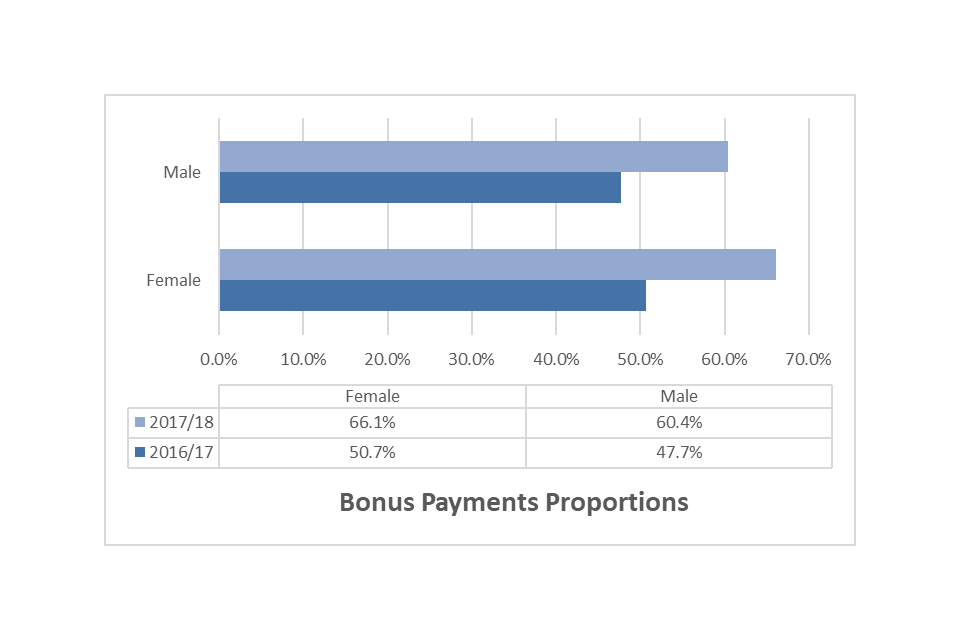
Bonus Payments Proportions
Closing the gender pay gap
DFID is committed to closing the gender pay gap and being proactive in creating a level playing field and increasing opportunities for women across the whole of the organisation. The gender pay gap data is a snapshot taken at 31 March each year which provides us with valuable data and will allow us to build a yearly picture of the progress we are making.
Closing the gender pay gap is an integral part of our approach to Diversity and Inclusion. As our pay gap is largely a result of having proportionately more men than women at senior grades, and proportionately more women than men at lower grades, the most effective way of closing the gender pay gap is to work to close the gap between the grade distributions of men and women. The key elements of how we address this are:
Recruitment
We aim to recruit a talented and diverse workforce which reflects the society we serve. When advertising roles, we ensure that gender neutral language is used and anonymous recruitment is in operation for grades A1 and below to ensure a fair recruitment strategy.
We also have an existing policy of no single-sex interview panels at all grades, unless by exception, as well as promoting diverse panels at all grades. Interviews for all roles are conducted in a structured manner, with all candidates asked the same predetermined questions and graded using standardised criteria, which helps reduce the risk of unfair bias influencing decisions.
Progression
DFID has already seen positive progression in more women taking up senior roles especially in SCS grades; 47% of our SCS are women, up from 31% 10 years ago. Our current SCS Pay Band 3 (Director General) roles are equally split between the genders with 2 males and 2 females in post.
DFID continues to work to remove barriers to career progression for all talented staff under-represented in our senior grades by encouraging participation in Civil Service Talent Programmes such as the Positive Action Pathway and Future Leaders Scheme for staff at grade A1 and below, and the Senior Leaders Scheme which is open to those at SCS Pay Band 1. These are development programmes for employees to build the skills and experience to progress in their careers and move into senior roles.
Mentoring and coaching are available to all staff through the matching service provided by Civil Service Learning, allowing staff to personalise their development to their own level and speed of progression as required.
Career Paths
In addition to development programmes for existing employees, DFID also offers apprenticeships and internships to provide access to opportunities, stretch and networks for individuals to reach their potential.
DFID staff within the UK have access to flexible working arrangements, supporting work-life balance. Most overseas offices also offer some flexible working. This allows our staff opportunities to progress their careers while providing them with personal flexibility. As an example of our ambition to maximise inclusion in our workforce, we have worked with networks to highlight the opportunity of Shared Parental Leave; the uptake within DFID has almost doubled from 9 to 17 in 2017 to 2018. Our Shared Parental Pay mirrors our Maternity Pay arrangements.
Pay Policy
During the final quarter of 2016 to 2017, DFID introduced an in-year award scheme. The analysis of a pilot of this scheme showed proportionate diversity outcomes for our men and women; awards were proportionally distributed across all employee groups within the organisation. We will develop this approach in line with our performance management processes to minimise biases and ensure equality. Guidance is provided for managers to help them understand the policy and ensure decisions are objectively considered.
We will continue to consider mechanisms for progression to enable us to manage pay disparities highlighted.
DFID’s Networks
DFID has a range of 14 staff networks which continue to play a vital role in delivering workplace inclusion for all our employees. The value of the networks is recognised in DFID and we encourage those who play key roles in networks to include this as part of their performance objectives.
An example is the women’s network, whose overall objective is to support and inspire women at all levels in DFID to achieve their potential. Its work focuses on a number of activities, such as:
- inspiring women - through events, external speakers, workshops and seminars
- building confidence - through networking, mentoring and learning from others
- empowering women - overcoming barriers to success and engaging on key issues that affect them
Additional Information
Clarification of Grades
DFID uses the Civil Service grade structure using the following names:
- A1 – Grade 6
- A2 – Grade 7
- A2L – Senior Executive Officer
- B1 – Higher Executive Officer
- B2 – Executive Officer
- C1/C2 – Admin Officer
Regulations
For further information on the Gender Pay Gap including definitions of in-scope employees, please consult the statutory regulations: The Equality Act 2010 (Specific Duties and Public Authorities) Regulations 2017.
The Department for International Development leading the UK government’s fight against world poverty.
Department for International Development
22 Whitehall
London
SW1A 2EG
UK
and at:
Abercrombie House
Eaglesham Road
East Kilbride
Glasgow
G75 8EA
UK
Tel: +44 (0)20 7023 0000
Fax: +44 (0)20 7023 0016
Twitter: @DFID_UK
Email: enquiry@dfid.gov.uk
Public enquiry point: 0845 3004100 or +44 1355 84 3132 (if you are calling from abroad)
Copyright in the typographical arrangement and design rests with the Crown. This publication (excluding the logo) may be reproduced free of charge in any format or medium, provided that it is reproduced accurately and not used in a misleading context. The material must be acknowledged as Crown copyright with the title and source of the publication specified.
Published by the Department for International Development
-
ONS Civil Service Workforce Data Report; 2018, PDF 333KB. The ONS report has different definitions for which employees are in scope. ↩
-
This table does not contain any information about C2 grade or any talent programmes run by DFID due to small numbers of individuals. Only individuals who are in scope for gender pay gap reporting are included in this table. Figures may not match other reports where different employee groups have been used. ↩
-
Due to rounding, this may not sum with other figures. ↩
-
Due to rounding, this may not sum with other figures. ↩
